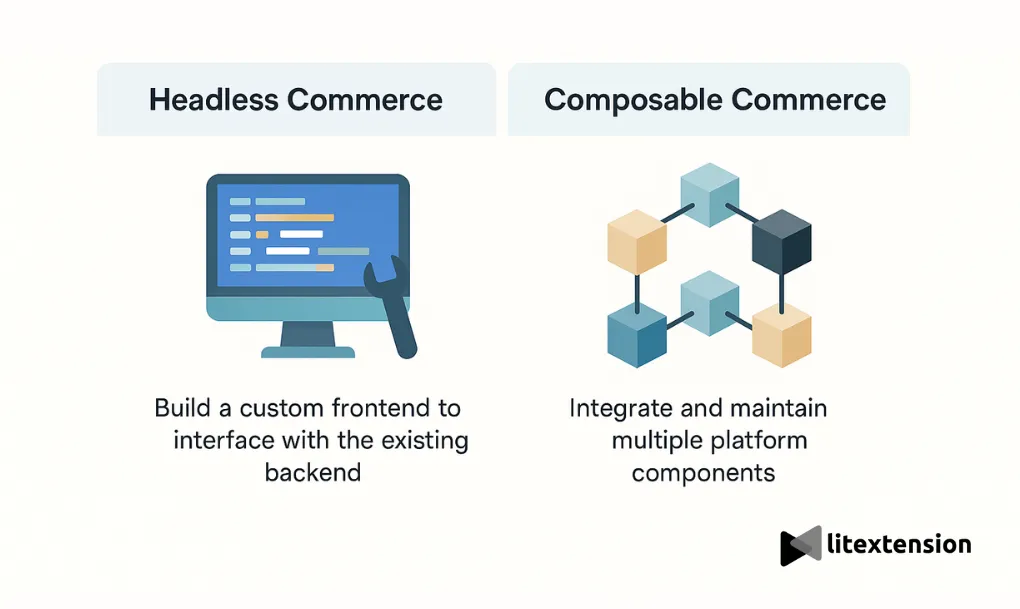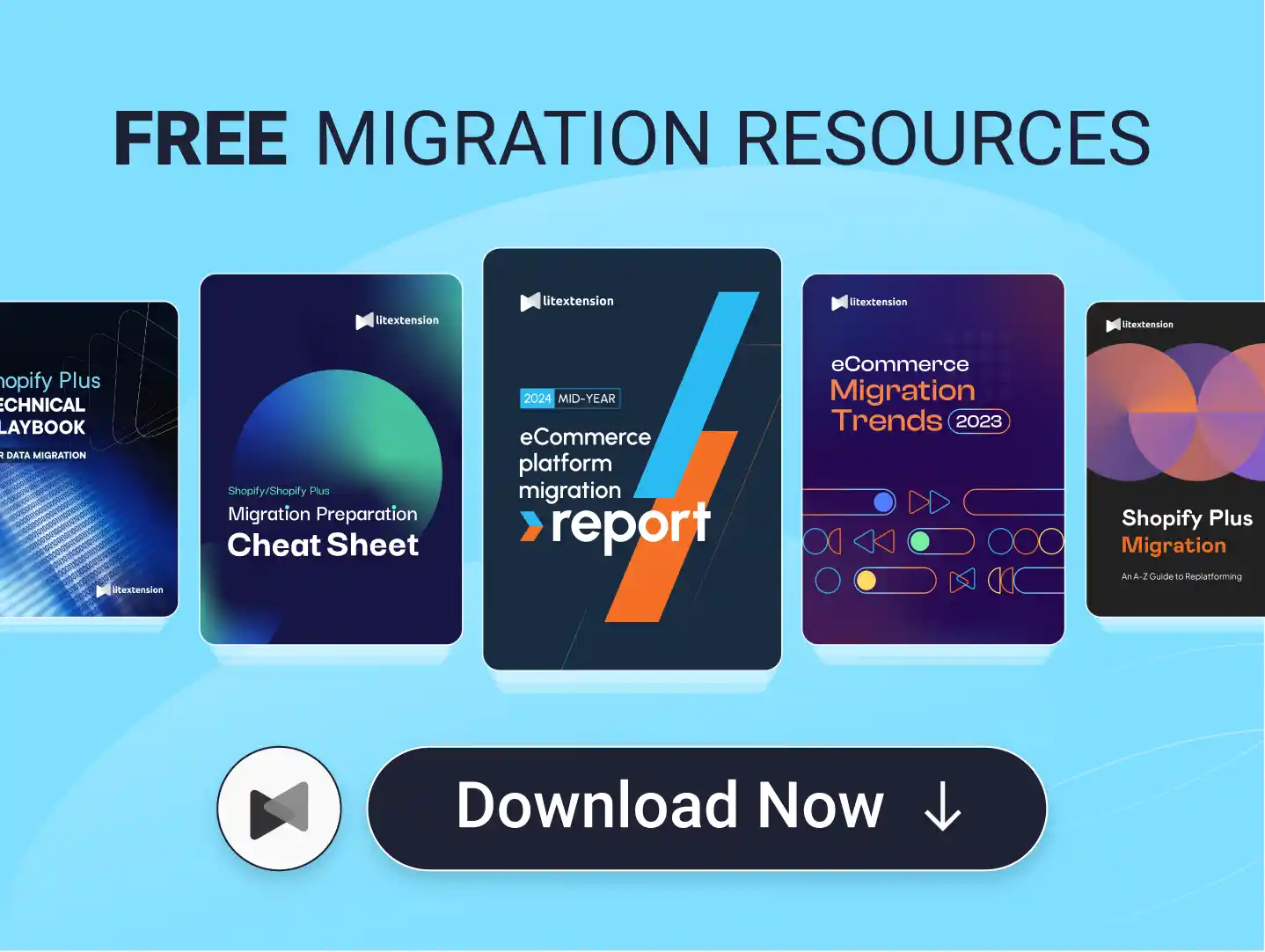As more B2B companies shift their focus online, they face new customer expectations, advanced technology, and growing competition. That’s why it’s important to understand the B2B eCommerce trends shaping the future to stand out in the crowded market and stay ahead of the game.
In this article, we'll present:
- The B2B eCommerce growth in numbers;
- The future of B2B eCommerce in 2026;
- B2B eCommerce trends that are still relevant;
- How brands can stay ahead of the curve.
Without further delay, let's get started!
The B2B eCommerce Statistics in 2024
Before getting to the trends in B2B eCommerce, let's first take a look at the business-to-business market in the previous year to understand the momentum behind it.
- As reported by Adobe, by 2027, the B2B eCommerce market can reach a total revenue of $9.6 trillion globally.
- In 2024, the Asia-Pacific (APAC) became the region with the largest B2B spending at $2,690,865 million, followed by North America and Europe. This distribution is forecasted to keep its pattern until 2027.
- According to eMarketer, the total B2B eCommerce sales revenue continues to grow at a steady pace, reaching $11.4 trillion in 2030.
- Think with Google also suggests that over 90% of B2B customers who engaged with a better mobile experience are likely to re-purchase from the same store.
B2B eCommerce Trends and Predictions for 2026
As we may see from the stats, the B2B eCommerce market is moving quickly, and businesses that want to grow must be ready to adapt. As we look ahead to 2026, it’s clear that digital tools, buyer behavior, and global market demands will continue to push the industry forward. Companies that understand these shifts early will have a strong advantage over those that don’t.
To help you prepare, here are the top B2B eCommerce trends and predictions for 2026. Each trend highlights how technology, customer expectations, and innovation will shape the way B2B businesses operate in the near future.
#1. AI becomes the new sales team member
According to Salesforce, 83% of sales teams with AI saw revenue growth this year vs. 66% without AI. Currently, 40% of sales organizations are experimenting with AI, and an additional 41% say they have the technology fully implemented in their operations. These figures highlight a key fact: AI will be deeply integrated into every stage of the buyer journey, from initial contact to post-sale engagement. It won’t just support sales professionals; it will actively participate in the sales process.
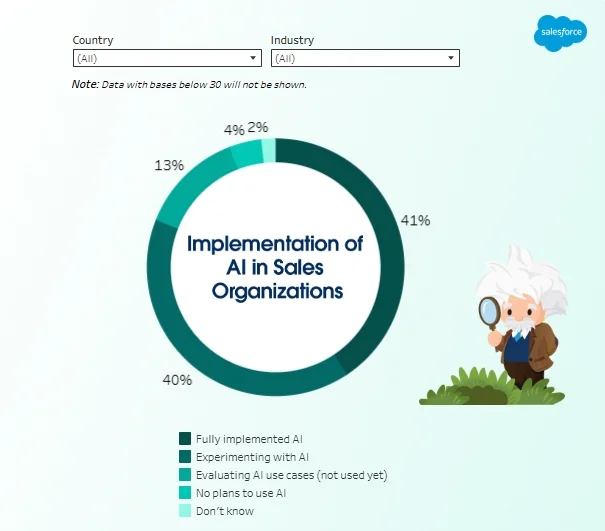
In the near future, most B2B sales journeys will begin with AI-powered assistants that engage prospects through real-time chat, suggest tailored product recommendations, and answer complex questions using company data. These systems will learn from every interaction, becoming smarter and more effective with time.
Sales reps will still play a key role, but their focus will shift toward building relationships, negotiating deals, and offering strategic guidance, while AI handles the background work. Predictive analytics will also give teams a clearer view of which prospects are most likely to convert, what they care about, and when to reach out.
As AI takes on more sales responsibilities, B2B brands need to think beyond short-term experiments. This shift calls for a clear, year-round strategy that defines how AI supports revenue growth.
#2. Self-service buyer journeys dominate B2B decision-making
One of the most impactful B2B eCommerce trends heading into 2026 is the shift toward self-service buyer journeys. As B2B customers grow more digitally savvy, they increasingly prefer to research, compare, and purchase products on their own, without relying on a sales representative.

According to Gartner’s Future of Sales report, 33% of buyers already prefer making purchases without involving sales reps, and that number is expected to rise. Supporting this trend, a recent Statista survey revealed that 39% of B2B buyers now prefer to access pricing information independently, rather than contacting a salesperson directly. These figures point to a clear future: the traditional sales-driven model is giving way to digital-first, buyer-led experiences.
By 2026, we can expect most B2B decision-makers to demand intuitive, seamless self-service options, especially during the research and pricing stages. Whether it’s through dynamic product catalogs, real-time inventory checks, or instant quote generators, companies that empower buyers with transparency and control will win their trust faster.
This shift also means that B2B websites and portals must evolve. Businesses will need to prioritize UX design, content clarity, and mobile accessibility to meet rising expectations. Self-service is no longer just a feature; it’s becoming the standard. As far as B2B eCommerce trends go, this one has the potential to completely transform how deals are closed and relationships are built.
#3. Headless and composable tech stacks replace legacy systems
Among the most transformative B2B eCommerce trends on the horizon, the shift from legacy systems to headless and composable architectures is advancing rapidly and shows no signs of slowing down. According to WP Engine, 73% of all businesses surveyed are already using headless website architecture, and this number continues to rise steadily year over year.
To begin with, headless commerce allows companies to decouple the front-end user experience from the back-end system. This separation gives developers more freedom to design, test, and launch personalized interfaces across multiple channels, without waiting for backend changes. Furthermore, composable commerce builds on this idea by enabling businesses to select and combine specialized services, such as product search, checkout, or content management, into a tailored solution that fits their exact needs.
As we move closer to 2026, we expect headless and composable systems to become the standard for B2B eCommerce infrastructure. Companies that delay this transition will likely face limitations in launching new digital experiences, integrating emerging technologies like AI, or supporting omnichannel buyer journeys.
#4. Mobile-first strategies and app adoption accelerate
As digital experiences continue to evolve, one of the most influential B2B eCommerce trends shaping the future is the rise of mobile-first strategies. Buyers are no longer tied to desktop environments; they’re researching products, placing orders, and managing accounts directly from their smartphones and tablets. By 2026, B2B companies that do not prioritize mobile-first design and app development will risk falling behind.
According to Statista, mobile commerce is projected to reach $2.5 trillion USD by 2025, accounting for a massive 68% of total retail orders. While this statistic reflects broader eCommerce behavior, the impact is just as strong in the B2B space. More procurement managers, field buyers, and distributors are relying on mobile tools for on-the-go product browsing, pricing checks, and fast reordering, especially in industries like manufacturing, construction, and wholesale.
Moreover, the rise of progressive web apps (PWAs), mobile portals, and integrated B2B apps is making it easier than ever to offer frictionless, app-like experiences across devices. Buyers now expect mobile platforms that load quickly, display real-time inventory, and support features like one-click reorder, saved carts, and mobile payment integration.
As we look ahead, mobile-friendly design will no longer be a nice-to-have; it will be a core requirement. B2B companies that embrace mobile-first strategies will benefit from faster purchasing cycles, higher engagement rates, and stronger customer loyalty. In contrast, those that neglect mobile optimization may see rising bounce rates, abandoned carts, and lost deals.
#5. Dynamic pricing models take center stage
As competition in digital marketplaces grows, one of the most strategic B2B eCommerce trends gaining traction is the adoption of dynamic pricing models.
Unlike traditional fixed pricing, dynamic pricing allows companies to adjust their rates based on multiple factors, such as order volume, purchase history, customer segment, and even competitor pricing. This level of flexibility enables sellers to stay competitive, win more deals, and protect margins in fast-moving markets.
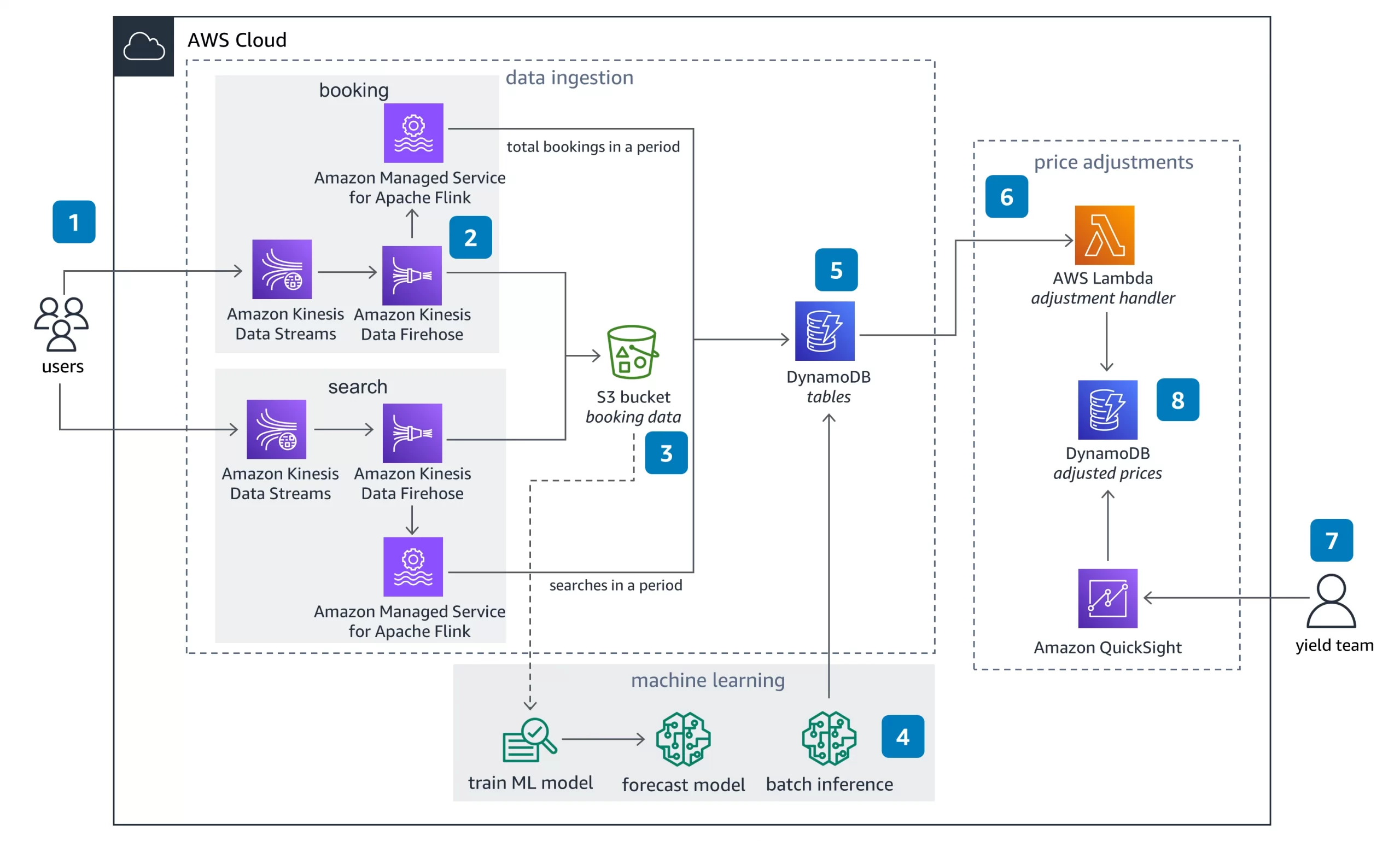
In fact, many B2B customers already expect volume-based discounts, contract-specific pricing, or instant quotes based on custom configurations. Dynamic pricing tools help automate these scenarios, reducing the need for back-and-forth negotiations and speeding up the purchasing process.
To stay ahead of these B2B eCommerce trends, brands should invest in pricing technology that connects seamlessly with their eCommerce platforms, CRM systems, and inventory tools. By doing so, they can unlock smarter pricing strategies that support both customer loyalty and revenue growth.
#6. Product discovery and enriched content becomes conversion drivers
Another powerful shift among the rising B2B eCommerce trends is the increasing role of product discovery and content enrichment in driving conversions. As digital buying journeys grow more self-directed, B2B buyers expect the same level of clarity, speed, and content depth that they’re used to in B2C experiences. By 2026, companies that invest in smarter discovery tools and high-quality content will see measurable gains in engagement, trust, and ultimately, increase sales volume.
Product discovery is no longer just about site search; it now involves AI-powered recommendations, advanced filters, personalized browsing, and intuitive category structures that help buyers find exactly what they need in seconds. This is especially critical in B2B, where catalogs can include thousands of SKUs and complex product variations.

At the same time, enriched content has become essential for decision-making. B2B buyers are looking for more than just basic specs; they want 360-degree images, how-to videos, application guides, user manuals, certifications, customer reviews, and even 3D previews or AR tools. These content elements build confidence and reduce the friction that slows down buying decisions.
As we approach 2026, brands that prioritize discoverability and content depth will outperform competitors that rely on outdated, static catalogs. This trend marks a shift from transactional websites to value-driven digital experiences, where content educates, guides, and converts. For companies looking to future-proof their strategies, enhancing product discovery and enriching content should be a top priority on their roadmap.
#7. Order fulfillment and shipment visibility rise to the top
Now that customers have discovered your products, their purchase journey does not end there. As we move toward 2026, one of the most critical B2B eCommerce trends will be the growing importance of order fulfillment and shipment visibility. Buyers want to know exactly when their orders will arrive, where they are in transit, and how quickly issues will be resolved if something goes wrong.
Historically, B2B supply chains have been complex and opaque. But in a post-pandemic world where delays, disruptions, and unpredictability have become common, customer expectations have shifted dramatically. Real-time tracking, automated notifications, and seamless updates are no longer optional; they’re expected. Businesses that can’t provide visibility risk losing buyer trust and repeat business.
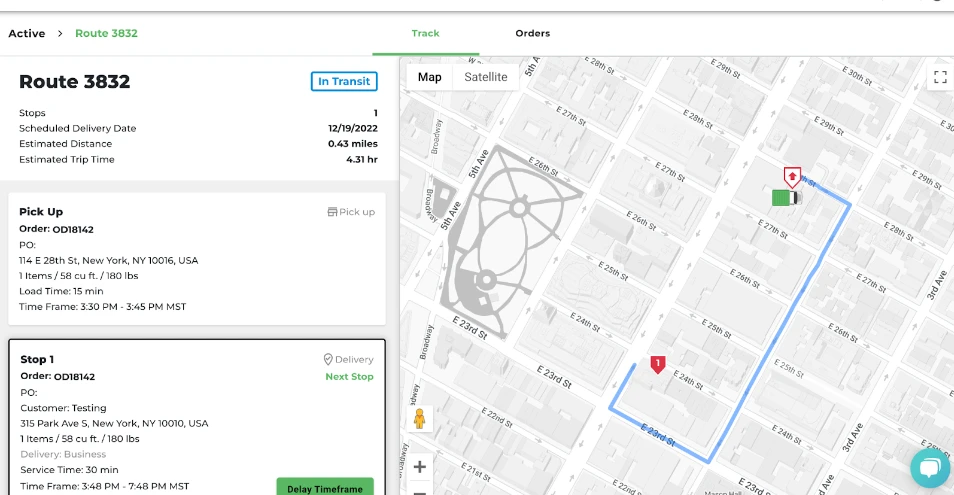
To meet these expectations, B2B sellers are increasingly turning to smart logistics tools powered by AI, IoT, and advanced APIs. These technologies allow for proactive alerts, accurate delivery ETAs, and even rerouting options when delays occur. Additionally, fulfillment systems integrated with inventory management and customer portals enable buyers to check stock availability, view order statuses, and manage returns without needing to contact support.
By 2026, order transparency will become a key differentiator in B2B eCommerce trends. Just as fast delivery became a competitive edge in B2C, fulfillment speed and visibility will drive loyalty and satisfaction in B2B. Brands that invest in logistics technology now will be better prepared to offer the reliable, flexible fulfillment experience buyers demand.
#8. Sustainability and ethical sourcing influence B2B buying decisions
Sustainability is no longer just a corporate social responsibility goal; it’s becoming a key driver of purchasing behavior in B2B. As one of the most value-driven B2B eCommerce trends heading into 2026, sustainability and ethical sourcing will play a central role in shaping how businesses evaluate suppliers, build partnerships, and position their brand in the marketplace.
In the near future, we’ll see a rise in sustainability scorecards, supplier audits, and data-sharing platforms that help buyers assess the impact of their purchasing decisions. B2B eCommerce platforms will also need to evolve, enabling businesses to filter products by eco-certifications, clearly view sustainability claims, and access documentation that proves compliance with environmental standards.
Additionally, companies that invest in traceability tools, such as blockchain for transparent sourcing or IoT sensors for monitoring carbon output, will gain a competitive edge. These technologies won’t just reduce environmental impact; they’ll also build trust with increasingly conscious buyers.
B2B eCommerce Trends That Are Still In The Picture
While new technologies and buyer behaviors are reshaping the future of B2B commerce, several earlier B2B eCommerce trends remain highly relevant in 2024 and beyond. These trends may no longer dominate headlines, but they continue to influence how businesses operate, connect with customers, and drive revenue in meaningful ways.
From omnichannel strategies to flexible payment models, these established practices have proven their long-term value, and they’re still playing a critical role in shaping digital success. In this section, we’ll highlight the key trends that haven’t faded away, but instead have matured into essential pillars of modern B2B eCommerce strategy.
Omnichannel selling
Among the enduring B2B eCommerce trends, omnichannel selling continues to be a critical part of the digital buying experience. Even as new technologies emerge, B2B buyers still expect a seamless journey that blends both digital and human touchpoints, whenever and wherever they choose to engage.
According to McKinsey’s B2B Pulse Survey, customers now use an average of ten different interaction channels throughout their buying journey. The top three most frequently used touchpoints are a company’s website, in-person sales, and video conferencing. But the journey doesn’t stop there; buyers also regularly engage through email, mobile apps, online chat, and e-procurement portals, showing how diverse and layered the path to purchase has become.
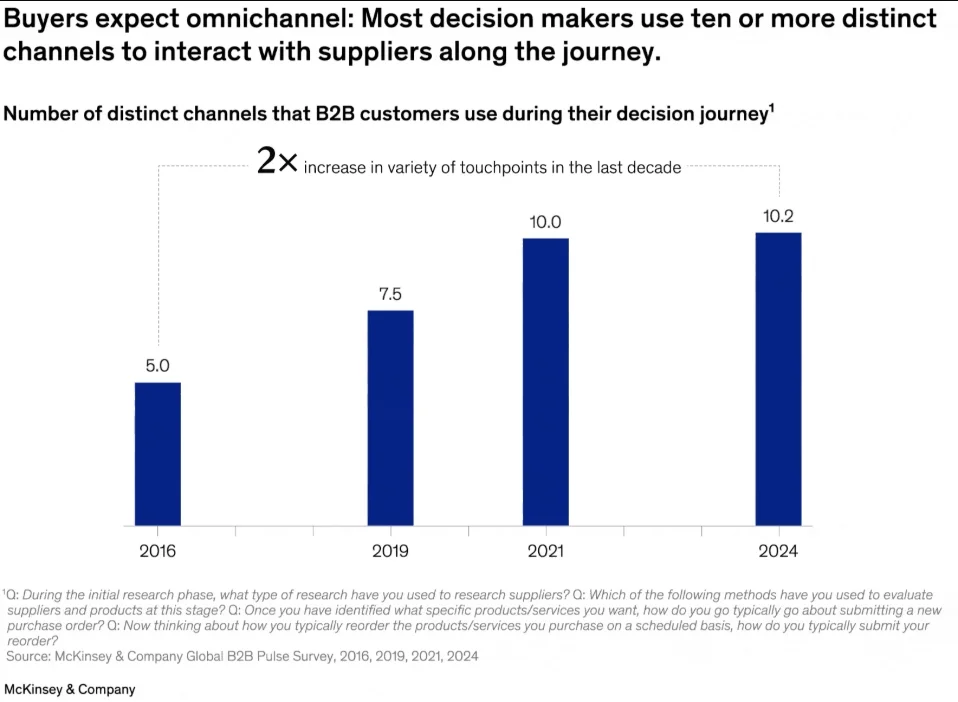
This continued trend highlights the need for consistency across all channels. Whether a buyer is browsing a website, speaking to a rep face-to-face, or following up via email, they expect the same information, pricing, and service quality. Any disconnect between touchpoints can cause friction, delays, or even lost sales.
As we move closer to 2026, successful B2B brands will be those that can unify their online and offline experiences. This means integrating CRM systems, ensuring real-time data syncing, and maintaining cohesive messaging across every stage of the buyer journey.
Social commerce
Once seen as a tool for brand awareness alone, social media has firmly established itself as a powerful driver of B2B purchasing decisions. As one of the B2B eCommerce trends that continues to grow in influence, social commerce is playing a bigger role in how buyers discover products, evaluate vendors, and make informed decisions.
According to a report by LinkedIn Business, 75% of B2B buyers now use social platforms to guide their purchasing decisions. This behavior is no longer limited to early research; buyers are actively seeking product recommendations, reading peer reviews, and engaging with thought leadership content throughout the entire decision-making process.
LinkedIn, in particular, has emerged as a primary hub for B2B discovery, but platforms like YouTube, X (formerly Twitter), and even TikTok are seeing increased adoption among professional audiences. Short videos, expert interviews, webinars, and interactive posts are helping vendors showcase their products in more dynamic, engaging ways than static web pages alone can offer.
Looking ahead to 2026, we expect B2B brands to further integrate social commerce into their digital strategies, not just for marketing, but for conversion and customer engagement. This includes embedding product links in social posts, offering gated downloads, and even enabling direct lead capture from within social platforms.
Voice commerce
Although still emerging, voice commerce is quietly becoming one of the most promising B2B eCommerce trends to watch through 2026 and beyond. As voice technology becomes more accurate and accessible, B2B buyers are starting to explore new ways to interact with digital platforms, without ever touching a screen.
According to recent market data by Grand View Research, the global voice commerce market is projected to reach USD 186.28 billion by 2030, growing at an impressive CAGR of 24.6% from 2024 to 2030. This rapid expansion is fueled by the rising adoption of smart speakers, voice assistants on smartphones, and IoT-enabled devices that support voice-based commands and transactions.
While voice commerce has seen faster uptake in the B2C space, it’s quickly finding relevance in B2B use cases, particularly for repeat orders, inventory checks, shipment tracking, and hands-free purchasing in industrial or field environments. That's why heading into 2026, we expect more B2B platforms to begin integrating voice search, smart assistant compatibility, and voice-based navigation to streamline complex workflows and boost user efficiency.
These features won’t replace traditional eCommerce interfaces, but they will complement them, especially for businesses looking to enhance productivity and convenience.
Buy Now Pay Later
As B2B buyers continue to seek greater financial flexibility and smoother purchasing experiences, Buy Now, Pay Later (BNPL) solutions are one of the more adaptable B2B eCommerce trends. Once confined mainly to B2C, BNPL is now making its way into B2B commerce, giving buyers more control over cash flow while enabling sellers to close deals faster.
According to global payment data by Statista, BNPL accounted for 5% of all eCommerce payments worldwide in 2024, with the U.S. alone seeing a 6% share. While this growth has largely been driven by consumer markets, the underlying demand for short-term, interest-free payment options is quickly gaining traction among B2B buyers, especially SMBs and startups with limited working capital.
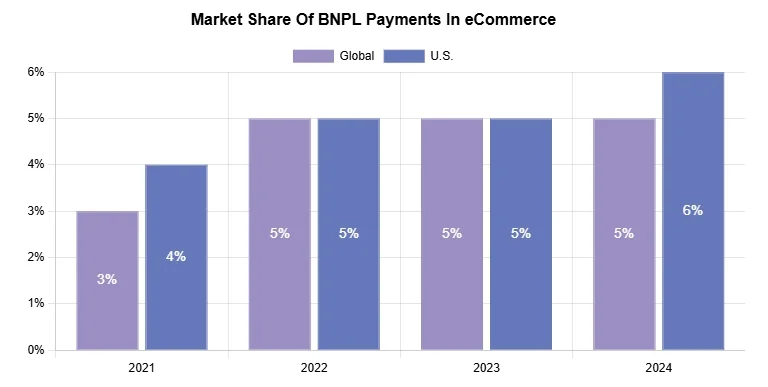
In B2B environments, BNPL can take the form of extended payment terms, installment-based billing, or third-party financing partners integrated directly into the checkout process. These models not only reduce purchase friction but also help vendors increase average order values and reduce cart abandonment.
By 2026, we expect BNPL offerings to become standard on B2B eCommerce platforms, particularly for mid-sized transactions and repeat orders. Buyers will increasingly expect these options at checkout, just like they do in their consumer experiences.
B2B eCommerce Trends – FAQs
What are the B2B eCommerce trends in 2025?
Some of the top B2B eCommerce trends expected in 2025 include the rise of self-service buyer journeys, increased adoption of AI-powered tools, a shift to headless and composable tech stacks, mobile-first strategies, and more focus on dynamic pricing and sustainability. These trends are reshaping how B2B companies attract, convert, and retain customers.
What is the B2B model of eCommerce?
The B2B (Business-to-Business) model of eCommerce refers to the buying and selling of goods or services between businesses through online platforms. Unlike B2C, which targets individual consumers, B2B eCommerce focuses on transactions between manufacturers, wholesalers, distributors, and other businesses.
What are the four types of B2B models?
The four main types of B2B models are:
- B2B2C (Business-to-Business-to-Consumer): Businesses sell to other businesses that then sell to end consumers.
- Wholesale: Businesses sell bulk products at discounted rates to other businesses for resale.
- Manufacturer: A manufacturer sells directly to businesses without intermediaries.
- Distributors: These businesses act as middlemen, buying from manufacturers and reselling to retailers or other buyers.
Is Shopify a B2B or B2C platform?
Shopify is primarily known as a B2C platform, but it also supports B2B eCommerce through features like wholesale pricing, customer groups, and integrations with ERP systems. Shopify Plus, in particular, is designed to meet the needs of B2B merchants looking to offer flexible, branded experiences to business buyers.
Final Thoughts
As we look toward 2026, it's clear that the future of B2B eCommerce will be shaped by agility, personalization, and smarter technology. From AI integration to mobile-first design and ethical sourcing, the B2B eCommerce trends discussed in this article highlight a market that’s becoming faster, more connected, and more buyer-centric than ever before.
However, staying competitive isn’t just about following trends; it’s about taking action. Businesses that invest early in innovation, improve digital experiences, and adapt to shifting buyer expectations will lead the way in both growth and customer loyalty.
Last but not least, for more expert insights, platform comparisons, and eCommerce best practices, explore other articles on the LitExtension blog.
